Abstract
The present study addresses a critical issue within the realm of drones: the challenge of distributed constrained optimization. Our research delves into an optimization scenario where the decision variable is confined to a closed convex set. The primary objective is to develop a distributed algorithm capable of tackling this optimization problem. To achieve this, we have crafted distributed algorithms for both balanced graphs and unbalanced graphs, with the method of feasible direction employed to address the considered constraint, and the method of estimating left eigenvector to address the unbalance, incorporating momentum elements. We have demonstrated that the algorithms exhibit linear convergence when the local objective functions are both smooth and strongly convex, and when the step-sizes are appropriately chosen. Additionally, the simulation outcomes validate the efficacy of our distributed algorithms.
1. Introduction
Recently, distributed optimization has emerged as a significant research area in drones, leading to substantial advances. During past years, although several attempts were made to employ distributed optimization algorithms to address the decision problems involved in drones (see [,]), their usage in multi-robot systems is still limited to only a handful of examples, as discussed in []. On the other hand, it is also mentioned in [] that many problems, including multi-robot target tracking, cooperative estimation, distributed simultaneous localization and mapping, and collaborative motion planning in multi-robot coordination and collaboration, can be formulated and solved within the framework of distributed optimization. Therefore, in this paper, we focus on designing novel distributed optimization algorithms and explore their potential applications in drones.
Recently, numerous influential results of distributed optimization have been achieved in this domain, encompassing both continuous-time distributed optimization algorithms (see [,,,,,,,]) and discrete-time distributed optimization algorithms (see [,,,,,,,,,,,,,,,,,,]). Notably, significant attention has been attracted by distributed constrained optimization, particularly with discrete-time algorithms designed for closed convex set constraints.
Initially, research primarily centered on distributed optimization algorithms that employed nonnegative decaying step-sizes, leading to algorithms with sub-linear convergence rates. The earliest studies addressed unconstrained optimization problems, with distributed algorithms over balanced graphs developed in []. Subsequent work expanded these methods to include closed convex set constraints in [] and global general constraints in []. When fixed unbalanced graphs were considered, distributed algorithms were developed to handle optimization problems with N non-identical set constraints in [] and those with additional equality and inequality constraints in []. Under time-varying unbalanced graph sequences, the Push-sum framework facilitated the design of distributed algorithms for unconstrained optimization in [], while an improved push–pull framework enabled solutions to problems with equality constraints and set constraints in [].
More recent efforts have emphasized the design of distributed optimization algorithms achieving linear convergence rates. In [], a distributed algorithm over balanced graphs was developed for unconstrained optimization, while further studies addressed the case of fixed unbalanced graphs in [,,]. For time-varying unbalanced graphs, the Push-DIGing algorithm and a push–pull-based algorithm were proposed in [,]. These methods, however, are limited to solving unconstrained optimization problems. For constrained cases, an algorithm over a fixed unbalanced graph was developed for problems with a closed convex set constraint in [].
Then, for further accelerating the convergence of the designed algorithms, the momentum terms were introduced in the proposed distributed optimization algorithms in [,,], where only the unconstrained optimization problems were studied. Moreover, the approach of employing momentum terms was later extended in the case with a global closed convex set constraint in []. Although the momentum-based algorithm in [] achieves linear convergence, its use of dual iterative scales adds computational complexity. Thus, this paper aims to design novel distributed optimization algorithms for solving the constrained optimization problem with only one iterative scale and thus with lower computational complexity.
This paper’s main contribution lies in proposing the distributed optimization algorithms with linear convergence and momentum terms for problems with a global closed convex set constraint. Utilizing the method of feasible directions to handle the constraint, this approach eliminates the need for the dual iterative scales used in [], thus reducing computational complexity.
We structure the remainder of the paper as follows. Section 2 introduces the relevant notations, graph theory, and matrix theory. Section 3 presents the decision problem of drones, the proposed distributed algorithm, the main theorem, and a detailed convergence analysis. In Section 4 and Section 5, the results of simulation and conclusions are given, respectively.
2. Preliminaries
2.1. Notations
In this paper, the n-dimensional real vectors set is denoted by the . Especially, denotes the vectors with a proper dimension and all entries being 1. Let be a vector; denotes its i-th entry, and denotes its transpose. Moreover, stands for its 2-norm. Especially, if all , are positive (non-negative), x is called positive (non-negative). Moreover, stands for the vectors with a proper dimension and with its i-th entry being 1 and other entries being 0. Additionally, for a function defined on , represents the gradient of f at x. Let denote the -dimensional real matrices set. Especially, denotes the real identity matrix with a proper dimension. Let be a matrix; its transpose and the 2-norm induced matrix norm are, respectively, denoted by and . Moreover, its -th is denoted by . Especially, if all , , are positive (non-negative), M is called positive (non-negative). Moreover, for a closed convex set and a vector w, denotes the projection of w on .
2.2. Graph Theory
In this paper, the notations and definitions associated with the graph are the same as those described in [] and thus are omitted here.
2.3. Matrix Theory
This subsection gives the definition of doubly stochastic matrices and the significant results of doubly stochastic matrices and non-negative matrices.
Definition 1.
Let be a non-negative matrix. A is called a non-negative stochastic matrix if . Moreover, A is called a non-negative doubly stochastic matrix if and .
Lemma 1
([,]). Let be a non-negative doubly stochastic matrix associated with the strongly connected directed graph . Especially, for all , suppose that are positive. Then, we have , with being a constant.
Lemma 2
([]). For a non-negative matrix , if holds for a positive constant θ and a positive vector , then .
3. Main Results
We will give the decision problem of drones, the proposed distributed algorithm and main theorem, and the convergence analysis in this section.
3.1. Decision Problem of Drones
In recent years, drones have seen significant application across various practical fields such as the military, terrain exploration, and power grid fault detection. As multi-scenario tasks become more complex, task completion often requires the coordination of multiple drones. Due to the lengthy time required and the lack of robustness in solving large-scale optimization problems, centralized optimal decision-making methods cannot meet the intelligent demands of multi-drone clusters for handling complex tasks. Consequently, distributed optimization algorithms are increasingly employed to enable efficient autonomous decision-making in multi-drone clusters. For instance, in terrain exploration tasks, the influence of complex terrain requires that multi-drone clusters consider not only their inherent optimization objectives but also the impact of terrain constraints on drone actions. Therefore, the autonomous decision-making problem for multi-drone clusters can be formulated as the following mathematical model:
where is the convex function representing the optimization objectives of drones and is a set being convex and closed standing for the constraint observed by drones. As discussed in [], for a optimal solution to problem Equation (1), it holds that
with being an arbitrary positive constant. Especially, let in the subsequent analyses for convenience, and the case with has been discussed in detail in [].
In the following, we first give a necessary assumption for problem Equation (1), which is standard and usually introduced in the works researching the distributed optimization algorithms having linear convergence.
Assumption 1.
All are L-smooth and α-strongly convex on , where α and L are positive constants.
3.2. Proposed Distributed Algorithm and Main Theorem
In this subsection, the distributed optimization algorithm is designed on the strongly connected balanced graph , and the main theorem about the proposed algorithm owing linear convergence is given.
Especially, motivated by [,], the discrete-time distributed algorithm is designed as in Algorithm 1, where is the estimation on the optimal solution of node i at a; A is the weighted matrix associated with , which is assumed to be non-negative doubly stochastic; is the estimation on the gradient of h of node i at a; and , , and are fixed step-sizes. Especially, can be arbitrarily selected in and .
| Algorithm 1: Distributed Algorithm over Balanced Graph |
|
I: Input: , , , N, A; II: Initialize: For all i, , ; III: Iteration rule: with VI: Output |
For rewriting Equation (3) in compact form and thus the convenience in the subsequent analysis, we introduce the following variable:
and . Then, we can rewrite Equation (3) as
Theorem 1.
With the feasible step-sizes α, β, and η, whose feasible regions are detailedly defined in the subsequent convergence analysis, for all under Algorithm 1 converge to the unique optimal solution to problem Equation (1) linearly under Assumption 1.
Proof.
See Section 3.3 for the detailed proof. □
3.3. Convergence Analysis for Algorithm 1
The detailed convergence analysis of Algorithm 1 is shown in this subsection, with the strict proof of Theorem 1 given.
Moreover, we introduce several variables necessarily involved in the subsequent convergence analysis, which are defined as
Lemma 3.
For Algorithm 1, one has
Proof.
This proof is omitted here since it can be easily completed based on the proof of ([] [Lemma 6]). □
Next, by introducing the variable as
we give a key lemma for establishing the linear convergence property of Algorithm 1.
Lemma 4.
Under Assumption 1 and when , there holds
where
Proof.
See Appendix A for the detailed proof. □
In the following, the detailed proof of Theorem 1 is prepared.
Proof of Theorem 1.
Clearly, it is sufficient for completing the proof to select the feasible step-sizes , , in order to make . Considering , we can select . Furthermore, noting Lemma 2, we can complete the proof by proving that there is a positive vector satisfying , i.e.,
Then, substituting into Equation (8), we can obtain
which is equivalent to
Since , , and L are positive, if , , , , and exist, which are positive constants, such that
holds, positive constants , , , , , and exist such that Equation (10) holds. For arbitrary positive constant , considering with , we select , , and , with , , and . Then, when
3.4. Distributed Algorithm on Unbalanced Graph
It can be noted that in Section 3.2, we only consider the case that the communication graph between all drones is balanced, which means that any two directly connected drones (agents) can exchange information bidirectionally. However, in many cases that require privacy protection, the information exchange between two directly connected drones (agents) is unidirectional, which implies that the communication graph between all drones is unbalanced. Furthermore, it is difficult to design a nonnegative doubly stochastic matrix for an unbalanced graph, and a nonnegative stochastic matrix is always employed in the distributed optimization algorithms for cases involving the unbalanced graphs.
Accordingly, when matrix A is only the stochastic matrix, Algorithm 1 is ineffective to address the problem in Equation (1), and we will take the case without the constraint and without the momentum terms , for example, to explain the detailed reason. When the constraint and the momentum terms are omitted, Algorithm 1 can be rewritten as
with the definition of being the same as that in Section 3.2.
It is worth noting from Lemma 3 that can be approximatively seen as the gradient of the global objective function h at upon all achieving consensus. Moreover, from the property of the non-negative doubly stochastic matrix as given in Lemma 2, we can obtain that all achieve consensus linearly. Furthermore, for the consensus state , we have
which can be approximatively seen as the classical gradient-decent iteration for obtaining the minimum of . Therefore, all under Algorithm 1 will converge to the minimum of .
However, as discussed in [], when A is only a non-negative doubly stochastic matrix, the result in Lemma 2 will become where is a nonnegative left eigenvector of A with respect to the eigenvalue 1, satisfying . Then, we should re-define and as
and can obtain that all will converge to the consensus state and . Therefore, can only be approximatively seen as the gradient of rather than , and thus Algorithm 1 will not converge to the minimum of the .
Clearly, if the detailed information of can be exactly obtained, the terms in Algorithm 1 can be modified as
to ensure that Algorithm 1 is still effective, with A being the only non-negative stochastic. However, it is difficult to exactly obtain the detailed information of in most cases, and thus the iteration
with all , is designed to estimate . Furthermore, as discussed in [], all will converge to linearly, and thus will converge to linearly. Finally, with the idea of estimating , we can modify the term in Algorithm 1 as
to ensure that Algorithm 1 is still effective, with A being only non-negative stochastic.
Finally, motivated by [,], the distributed algorithm over the unbalanced graph is designed as in Algorithm 2.
| Algorithm 2: Distributed Algorithm over Unbalanced Graph |
|
I: Input: , , , N, A; II: Initialize: For all i, , , ; III: Iteration rule: with VI: Output |
Let
we can rewrite Equation (17) with the unbalanced graph as
Theorem 2.
With the feasible step-sizes α and η, for all under Algorithm 2 converge to the unique optimal solution to problem Equation (1) linearly under Assumption 1.
Proof.
See Section 3.5 for the detailed proof. □
3.5. Convergence Analysis for Algorithm 2
Now, we can establish the convergence properties of Algorithm 2.
Lemma 5.
With the given initial values, one has
Let .
Proof.
This proof is omitted here as it can be readily accomplished based on the proof of ([] [Lemma 8]). □
Next, define the following variable as
Lemma 6.
Under Assumption 1 and when , there holds
where and are defined as
Proof.
See Appendix A for the detailed proof. □
With Lemma 6, the proof of Theorem 2 can be similarly completed based on the proof of Theorem 1; therefore, we omit it.
Remark 1.
It can be obtained from the proof of Theorem 1 that with the desired step-sizes α, β, and η, the optimal error satisfies
where is a positive constant. Therefore, for an arbitrarily small positive constant ϵ, it is necessary to execute Algorithm 1 at least times to ensure that , while times are needed for Algorithm 1 in [], where M is a positive constant satisfying with being a constant. Clearly, Algorithm 2 in this paper and Algorithm 2 in [] have the similar case with respect to the computational complexity.
4. Simulations
Here, a simulation example is shown to verify the theoretical results developed in this paper. Especially, the multi-drones target tracking problem is considered for the simulation in this paper, which was also discussed in [] and can be simplistically formulated as
where N represents the number of drones for tracking the moving target; T represents the number of moving steps of the target; and , with being the real state of the target at step t and being the sampling value at step t of the random variable introduced to represent the measurement noise of the drone i. The aim of this task is employing N drones to track the real target trajectory , , ⋯, . Especially, in this simulation, N is selected as 8, T is set as 5, , and takes values in randomly and uniformly. For convenience, all values of the parameters involved in this simulation are collected in Table 1.

Table 1.
Values of parameters.
Moreover, it is assumed that the state of the moving target at the step t is contained in , which is selected as for all . Additionally, the balanced communication graph necessarily involved in the distributed Algorithm 1 is depicted as in Figure 1. Accordingly, we selected the weighted matrix A as
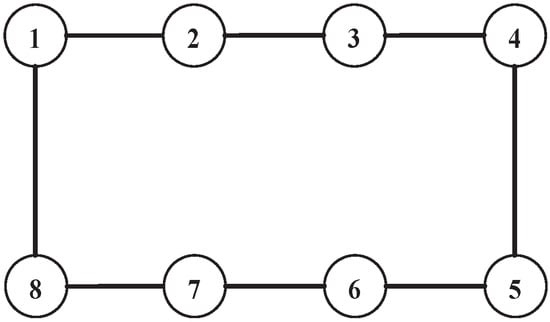
Figure 1.
Balanced graph with eight interacting agents.
Moreover, the step-sizes are selected as , , and in this simulation, respectively. Especially, in Figure 2, the transient behaviors of all under Algorithm 1 are shown, which shows that all under Algorithm 1 converge to the unique optimal solution .
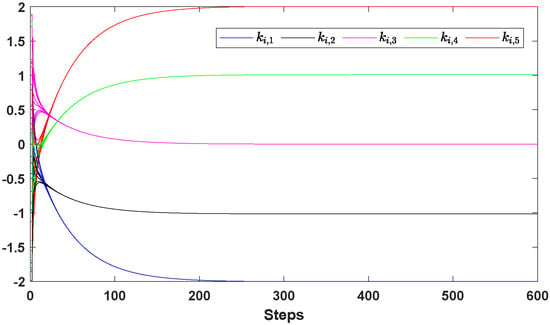
Figure 2.
Behaviors of the states under Algorithm 1.
Furthermore, with the same settings except that the unbalanced communication graph necessarily involved in the distributed algorithm (18) is depicted as in Figure 3 and the weighted matrix A is selected as
the transient behaviors of all under Algorithm 2 are shown in Figure 4, which shows that all under Algorithm 2 converge to the unique optimal solution .
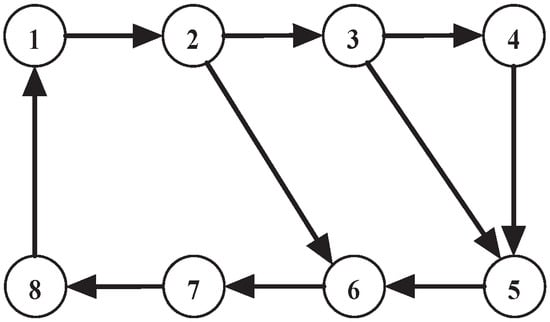
Figure 3.
Unbalanced graph with eight interacting agents.
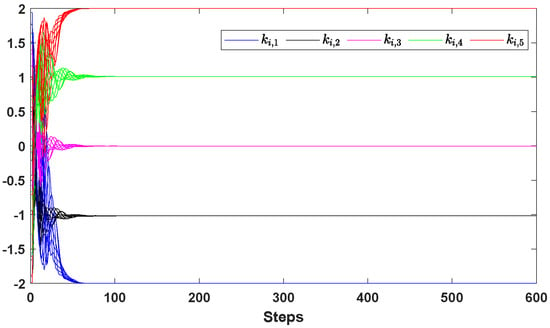
Figure 4.
Behaviors of the states under Algorithm 2.
Moreover, in order to highlight the good performance at reducing the computational complexity compared to Algorithm 1 in [], the simulations of Algorithm 1 in this paper and Algorithm 1 in [] under the same settings are further made. Especially, we introduce the convergence index (CI) as
with and show the transient behaviors of CI under two Algorithms in Figure 5 for comparison. It can be seen from Figure 5 that two distinct Algorithms share a similar convergence rate. On the other hand, the operating time of GPU with different Algorithms is recoded during the simulations, which shows that for obtaining the similar convergence performance, s is required for Algorithm 1 in this paper, while s is needed for Algorithm 1 in [].
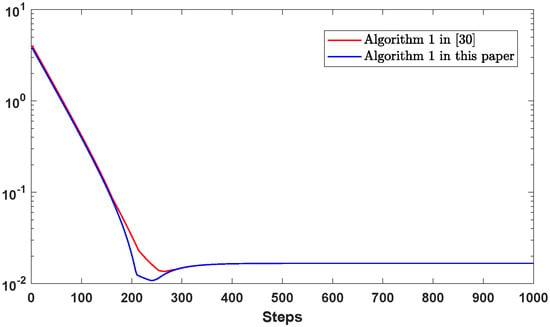
Figure 5.
Behaviors of the CI under Algorithm 1 in this paper and under Algorithm 1 in [].
Additionally, in order to explore how the momentum parameters affect the convergence rate, the simulations of Algorithm 1 with different momentum parameters are further made under the same other settings. Furthermore, the transient behaviors of CI under Algorithm 1 with different momentum parameters are shown in Figure 6 for comparison, which shows that the convergence rates in terms of the CI under Algorithm 1 with bigger momentum parameters are faster than that with smaller momentum parameters, and Algorithm 1 is nonconvergent when the momentum parameter is too big ().
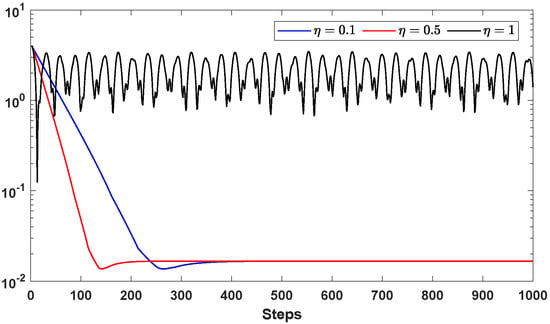
Figure 6.
Behaviors of the CI under Algorithm 1 with different .
Remark 2.
It is worth mentioning that although the definitions of the upper bound of the desired α, β, and η are given in Equations (12) and (13), it is still difficult to exactly give the explicit bounds of the desired α, β, and η since the global information L, μ, and ρ are necessarily involved in the definitions. On the other hand, it can also be noted from Equations (12) and (13) that the proposed Algorithms would be convergent when α, β, and η are sufficient small. Therefore, when carrying out the simulation for the proposed Algorithms, arbitrarily positive constants can be selected for the step-sizes first. Then, if the Algorithms with the selected step-sizes are nonconvergent, the smaller positive constants could be selected for the step-sizes until the Algorithms converge.
5. Conclusions
This paper has examined a constrained optimization problem within a closed convex set and designed a distributed algorithm incorporating momentum terms. Especially, the method of feasible direction and the method of estimating the left eigenvector have been employed to address the considered constraint and the unbalance, respectively. The algorithm’s linear convergence has been demonstrated with carefully chosen step-sizes, and the optimal ranges for these step-sizes are clearly defined. Compared to the existing algorithms designed in [], the algorithm proposed in this paper has lower computational complexity. Simulation results have confirmed the algorithm’s effectiveness. Future research will explore the impact of time-varying graph sequences and more complex constraints. Furthermore, further research will also explore overcoming the limitation of the increased complexity with respect to operating the designed algorithms in large-scale drone networks, accompanied with the momentum terms. Additionally, further research will also explore the sensitivity analysis on step-size settings and momentum parameters.
Funding
This work was supported by the National Natural Science Foundation of China under Grant No. 62203110, the Natural Science Foundation of Jiangsu Province under Grant BK20242027, the Elite Medical Professionals Project of China-Japan Friendship Hospital under Grant No. ZRJY2021-GG09, and the CAMS Innovation Fund for Medical Sciences (CIFMS)-Clinical and Translational Medicine Research under Grant No. 2020-I2M-C&T-B-093.
Data Availability Statement
The original contributions presented in this study are included in the article. Further inquiries can be directed to the corresponding author.
Conflicts of Interest
The author declares no conflicts of interest.
Appendix A
In this section, the proofs of Lemmas 4 and 6 are collected.
Proof of Lemma 4.
This proof mainly includes four steps where the bounds of , , , and are, respectively, established.
Then, based on Lemma 1 and the projection operator’s non-expansive property, we can obtain
Step 2: Bound . From Equation (6a), one has
Then, based on ([] [Lemma 7]) and with , we can obtain
where and
Then, noting that is also L-Lipschitz under Assumption 1, we have
Step 3: Bound . Directly, noting , we can obtain
which means that
Step 4: Bound . From Equation (5b), we can obtain
Then, from Equation (A7), we can obtain
Proof of Lemma 6.
This proof includes into four steps, which is the same as the proof process of Lemma 4.
Step 1: Bound . Similar to Equation (A10), we can obtain directly
Step 2: Bound . From Equation (19a), one has
According to ([] [Lemma 7]) and under the condition that , it follows that
It is clear that for all i that and are uniformly bounded with respect to a. Therefore, we assume that .
Based on Assumption 1, it follows from the forth term in the right-hand side of Equation (A12) that
where .
From Equation (A13), we have
According to Assumption 1, and by substituting Equation (A17) into Equation (A16), it is followed by that
Step 4: Bound . From Equation (18b), we obtain
References
- Shorinwa, O.; Haksar, R.N.; Washington, P.; Schwager, M. Distributed multirobot task assignment via consensus ADMM. IEEE Trans. Robot. 2023, 39, 1781–1800. [Google Scholar] [CrossRef]
- Huang, Y.; Kuai, J.; Cui, S.; Meng, Z.; Sun, J. Distributed Algorithms via Saddle-Point Dynamics for Multi-Robot Task Assignment. IEEE Robot. Automat. Lett. 2024, 9, 11178–11185. [Google Scholar] [CrossRef]
- Shorinwa, O.; Halsted, T.; Yu, J.; Schwager, M. Distributed optimization methods for multi-robot systems: Part 1-A tutorial. IEEE Robot. Automat. Mag. 2024, 31, 121–138. [Google Scholar] [CrossRef]
- Wang, J.; Elia, N. A control perspective for centralized and distributed convex optimization. In Proceedings of the 2011 50th IEEE Conference on Decision and Control and European Control Conference, Orlando, FL, USA, 12–15 December 2011; Volume 3, pp. 3800–3805. [Google Scholar]
- Gharesifard, B.; Cortés, J. Distributed continuous-time convex optimization on weight-balanced digraphs. IEEE Trans. Autom. Control 2014, 59, 781–786. [Google Scholar] [CrossRef]
- Hong, H.; Yu, X.; Yu, W.; Zhang, D.; Wen, G. Distributed convex optimization on state-dependent undirected graphs: Homogeneity technique. IEEE Trans. Control Netw. Syst. 2020, 7, 42–52. [Google Scholar] [CrossRef]
- Zhu, Y.; Yu, W.; Wen, G.; Ren, W. Continuous-time coordination algorithm for distributed convex optimization over weight-unbalanced directed networks. IEEE Trans. Circuits Syst II Exp Briefs 2019, 66, 1202–1206. [Google Scholar] [CrossRef]
- Liu, Q.; Wang, J. A second-order multi-agent network for bound-constrained distributed optimization. IEEE Trans. Autom. Control 2015, 60, 3310–3315. [Google Scholar] [CrossRef]
- Lin, P.; Ren, W.; Farrell, J.A. Distributed continuous-time optimization: Nonuniform gradient gains, finite-time convergence, and convex constraint set. IEEE Trans. Autom. Control 2017, 62, 2239–2253. [Google Scholar] [CrossRef]
- Yuan, D.; Ho, D.W.C.; Xu, S. Regularized primal-dual subgradient method for distributed constrained optimization. IEEE Trans. Cybern. 2016, 46, 2109–2118. [Google Scholar] [CrossRef] [PubMed]
- Yang, S.; Liu, Q.; Wang, J. A multi-agent system with a proportional-integral protocol for distributed constrained optimization. IEEE Trans. Autom. Control 2017, 62, 3461–3467. [Google Scholar] [CrossRef]
- Nedić, A.; Ozdaglar, A. Distributed subgradient methods for multi-agent optimization. IEEE Trans. Autom. Control 2009, 54, 48–61. [Google Scholar] [CrossRef]
- Nedić, A.; Ozdaglar, A.; Parrilo, P.A. Constrained consensus and optimization in multi-agent networks. IEEE Trans. Autom. Control 2010, 55, 922–938. [Google Scholar] [CrossRef]
- Zhu, M.; Martínez, S. On distributed convex optimization under inequality and equality constraints. IEEE Trans. Autom. Control 2012, 57, 151–164. [Google Scholar]
- Mai, V.S.; Abed, E.H. Distributed optimization over directed graphs with row stochasticity and constraint regularity. Automatica 2019, 102, 94–104. [Google Scholar] [CrossRef]
- Liu, H.; Zheng, W.X.; Yu, W. Distributed discrete-time algorithms for convex optimization with general local constraints on weight-unbalanced digraph. IEEE Trans. Control Netw. Syst. 2021, 8, 51–64. [Google Scholar] [CrossRef]
- Nedić, A.; Olshevsky, A. Distributed optimization over time-varying directed graphs. IEEE Trans. Autom. Control 2015, 60, 601–615. [Google Scholar] [CrossRef]
- Liu, H.; Yu, W.; Wen, G.; Zheng, W.X. Distributed algorithm over time-varying unbalanced graphs for optimization problem subject to multiple local constraints. IEEE Trans. Control Netw. Syst. 2024. [Google Scholar] [CrossRef]
- Qu, G.; Li, N. Harnessing smoothness to accelerate distributed optimization. IEEE Trans. Control Netw. Syst. 2018, 5, 1245–1260. [Google Scholar] [CrossRef]
- Xi, C.; Xin, R.; Usman, K.A. ADD-OPT: Accelerated distributed directed optimization. IEEE Trans. Autom. Control 2018, 63, 1329–1339. [Google Scholar] [CrossRef]
- Xi, C.; Mai, V.S.; Xin, R.; Abed, E.H.; Khan, U.A. Linear Convergence in Optimization Over Directed Graphs With Row-Stochastic Matrices. IEEE Trans. Autom. Control 2018, 63, 3558–3565. [Google Scholar] [CrossRef]
- Pu, S.; Shi, W.; Xu, J.; Nedić, A. A push-pull gradient method for distributed optimization in networks. IEEE Trans. Autom. Control. 2020, 66, 1–16. [Google Scholar] [CrossRef]
- Nedić, A.; Ozdaglar, A.; Shi, W. Achieving geometric convergence for distributed optimization over time-varying graphs. SIAM J. Optim. 2017, 27, 2597–2633. [Google Scholar] [CrossRef]
- Saadatniaki, F.; Xin, R.; Khan, U.A. Decentralized optimization over time-varying directed graphs with row and column-stochastic matrices. IEEE Trans. Autom. Control 2020, 65, 4769–4780. [Google Scholar] [CrossRef]
- Liu, H.; Yu, W.; Chen, G. Discrete-time algorithms for distributed constrained convex optimization with linear convergence rates. IEEE Trans. Cybern. 2022, 52, 4874–4885. [Google Scholar] [CrossRef]
- Liu, H.; Yu, W.; Zheng, W.X.; Nedić, A.; Zhu, Y. Distributed constrained optimization algorithms with linear convergence rate over time-varying unbalanced graphs. Automatica 2024, 159, 111346. [Google Scholar] [CrossRef]
- Xin, R.; Khan, U.A. Distributed heavy-ball: A generalization and acceleration of first-order methods with gradient tracking. IEEE Trans. Autom. Control 2020, 65, 2627–2633. [Google Scholar] [CrossRef]
- Li, H.; Cheng, H.; Wang, Z.; Wu, G.-C. Distributed Nesterov gradient and heavy-ball double accelerated asynchronous optimization. IEEE Trans. Neural Netw. Learn. Syst. 2021, 32, 5723–5737. [Google Scholar] [CrossRef]
- Gao, J.; Liu, X.; Dai, Y.-H.; Huang, Y.; Yang, P. A Family of Distributed Momentum Methods Over Directed Graphs With Linear Convergence. IEEE Trans. Autom. Control 2023, 68, 1085–1092. [Google Scholar] [CrossRef]
- Luan, M.; Wen, G.; Liu, H.; Huang, T.; Chen, G.; Yu, W. Distributed discrete-time convex optimization with closed convex set constraints: Linearly convergent algorithm design. IEEE Trans. Cybern. 2024, 54, 2271–2283. [Google Scholar] [CrossRef] [PubMed]
- Ren, W.; Beard, R.W. Consensus seeking in multiagent systems under dynamically changing interaction topologies. IEEE Trans. Autom. Control 2005, 50, 655–661. [Google Scholar] [CrossRef]
- Horn, R.A.; Johnson, C.R. Matrix Analysis; Cambridge University Press: Cambridge, UK, 2012. [Google Scholar]
Disclaimer/Publisher’s Note: The statements, opinions and data contained in all publications are solely those of the individual author(s) and contributor(s) and not of MDPI and/or the editor(s). MDPI and/or the editor(s) disclaim responsibility for any injury to people or property resulting from any ideas, methods, instructions or products referred to in the content. |
© 2025 by the author. Licensee MDPI, Basel, Switzerland. This article is an open access article distributed under the terms and conditions of the Creative Commons Attribution (CC BY) license (https://creativecommons.org/licenses/by/4.0/).